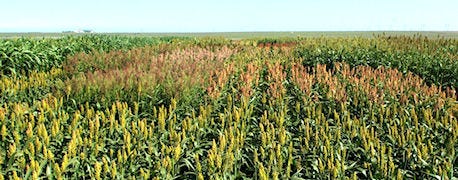April 7, 2015

With sorghum acreage gaining ground, some beef producers might be inclined to harvest sorghum silage over corn silage. While sorghum silage can provide an alternative, not all are created equal, according to Dr. Ellen Jordan and Dr. Ted McCollum, dairy and beef specialists for Texas A&M Extension.
Related: Sorghum residue similar in performance to corn stover
Jordan, the dairy specialist in Dallas, and, McCollum, the beef cattle specialist in Amarillo, shared that forages have key functions in beef and dairy diets – they're necessary to stimulate rumination and breakdown of feed.

Not all sorghums produce the same results when fed as silage to beef and dairy cows. (Texas A
Sorghum is an alternative in areas short of rainfall, Jordan said, because it allows for sustained production in drought conditions and for delayed planting if necessary. It also utilizes water more efficiently than corn and has high biomass yields.
"One limitation to sorghum silage fed to cattle is the digestibility is generally less than that of corn, because corn has less lignin and more grain," she said. "This can result in less fiber digestion, a lower dry matter intake and less milk produced in dairy cattle."
However, brown midrib, or BMR, genotypes of sorghum on average contain less lignin and do offer a higher digestibility, McCollum said, but the BMR genotype alone is not a guarantee of better quality.
Sorghum choice by animal use
Producers have several options where selection of sorghum type is concerned, and it is dependent on animal use, McCollum said.
Sorghum-sudangrass hybrids have coarser stems and broader leaves than true sudangrass. They are higher yielders than sudangrass, with better regrowth for grazing or multiple harvests.
The BMR forage sorghums are lower in lignin content in the leaves and stalks, and the quality, on average, is better than conventional sorghums.
Related: Thanks to China, grain sorghum gains more respect as exports climb
Photoperiod sensitive sorghums are very tall and remain in the vegetative state until day length is fewer than 12 hours and 20 minutes, which provides more flexibility in managing harvest of the crop.
There are caveats, McCollum said: They are slow to dry down and have to be swathed. They also tend to have the lower feed value of all the different types.
"What you are going to do with it will determine the sorghum silage you choose," he said. "For steers eating an 80-90% silage diet, you might pick the BMRs; but if it is a dry dairy cow that needs to be fed, you can grow the lower quality photoperiod sensitive forage sorghum.
"If I'm looking for energy value in my forage, I'm going to go to a BMR," McCollum said. "Pick a variety based on the desired fiber, tonnage, quality and starch. Use fiber quality as the primary criteria."
5 recommendations for harvesting, growing sorghum for silage (page 2) >>
~~~PAGE_BREAK_HERE~~~
Kernel digestibility consideration
A concern in feeding whole-plant forage sorghum silage is the low starch digestibility of the kernels, which are often too hard and unprocessed, he said.
"So if you want to ensure better starch availability in the sorghum silage, get out into the field and cut it early," he said. "If you can't process the grain head, you need to harvest early. And then leave it in the (silage) pit for as long as possible, because time, moisture and kernel softness are your best aids."
McCollum said the key to using sorghum silage instead of corn silage is to replace the corn silage on a fiber basis and not dry matter basis.
Harvesting, growing sorghum for silage
Important management steps to sorghum silage quality are:
1. Harvest early, soft-dough stage at the latest.
2. Target dry matter at 32-36%.
3. Swath if necessary to obtain the correct moisture.
4. Chop at about one-half inch.
5. Make sure the storage site is sloped to divert any water.
Jordan said BMR sorghum silage has been shown to support levels of production in mid-lactating dairy cows. It must be harvested and ensiled properly and producers should use inoculants per manufacturer's directions to improve dry matter preservation and bunk life.
Related: Sorghum research looks at manipulating lignin
She said sorghum silage should be able to be used for dry cow and heifer rations, although the research projects haven't been done. And more research is also needed on early lactation cows.
"If processed using steam flaking, sorghum and corn grain can be equal in starch value," Jordan said. "Sorghum can be an alternative to corn. It allows sustained production in drought."
Source: Texas A&M
You May Also Like




